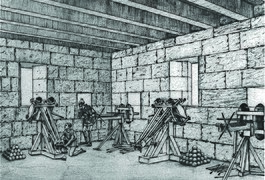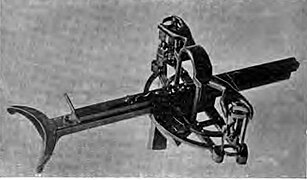The Greeks and Romans both made extensive use of artillery for shooting large arrows, bolts or spherical stones or metal balls. Occasionally they also used ranged early thermal weapons. There was heavy siege artillery, but more mobile and lighter field artillery was already known and used in pitched battles, especially in Roman imperial period.
The technology was developed quite rapidly, from the earliest gastraphetes in about 399 BC[1] to the most advanced torsion artillery in about 300 BC at the time of Demetrius Polyiorcetes. No improvement, except in details, was ever made upon the catapults of Demetrius.[2] The Romans obtained their knowledge from the Greeks, and employed the Greek specialists.
Five Greek and Roman sources have survived: two treatises by Heron of Alexandria, Belopoeika and Cheiroballistra; and the books by Biton of Pergamon, Philo of Byzantium and Vitruvius[3]
-
Greek non-torsion siege crossbow (gastraphetes)
-
Hellenistic era artillery tower with arrow shooters (euthytona) and stone throwers (palintona)
-
Hellenistic era semi-automatic bolt shooter (polybolos)
-
Roman imperial era bolt shooter (scorpio) bastion in defensive warfare
-
Roman imperial era mobile field artillery (carroballistae)
-
Handheld Roman imperial era manuballista or cheiroballistra
-
Late Roman era stone thrower (onager) used predominantly in sieges
- ^ [http://www.ascsa.edu.gr/pdf/uploads/hesperia/hesperia.80.4.0677.pdf "It is significant that neither Thucydides nor Xenophon mentions catapults. Although their silence cannot prove that no catapults existed, it nevertheless complements the broad picture of the development of bowmachines in the years leading up to 399 BC"
- ^ Cite error: The named reference
Tarnwas invoked but never defined (see the help page). - ^ Marsden, E.A. (1971). Greek and Roman artillery. Technical treatises. Oxford at the Clarendon press. ISBN 0198142692.







